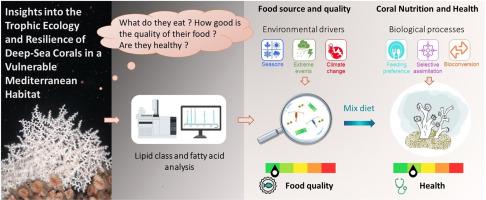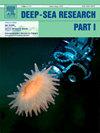In situ diet patterns and health status of cold-water corals in the Lacaze-Duthiers canyon (NW Mediterranean Sea): insights from fatty acid biomarkers on lipid classes
IF 2.1
3区 地球科学
Q2 OCEANOGRAPHY
Deep-Sea Research Part I-Oceanographic Research Papers
Pub Date : 2025-08-08
DOI:10.1016/j.dsr.2025.104573
引用次数: 0
Abstract
Hydrodynamic and food supply favourable conditions in the Lacaze-Duthiers Canyon (northwestern Mediterranean Sea) have supported the establishment of deep-sea corals, with some of the highest densities recorded in the Mediterranean. However, increasing pressures on these vulnerable habitats raise critical questions about their ecological status and resilience to environmental changes, emphasising the need to understand their trophic ecology. This study provides the most detailed analysis to date of the lipid profiles and fatty acid signatures of two key framework-building cold-water corals, Madrepora oculata and Desmophyllum pertusum (syn. Lophelia pertusa), offering insights into their feeding strategies, dietary requirements, and nutritional condition.
The results reveal that lipid classes exhibit distinct fatty acid compositions based on functional roles (storage vs. structural). Fatty acid trophic markers (FATM) indicative of herbivorous calanoids, carnivorous copepods, and phytodetritus were detected in the storage lipids (waxes and triglycerides) of both species, yet no FATM was specific to either species. This indicates a mixed diet and dietary overlap between the two corals. However, the composition of storage lipids varied significantly across samples, likely reflecting (1) species-specific feeding preferences, with D. pertusum showing greater reliance on overwintering copepods, and (2) the dynamic availability of food resources within the canyon.
Phospholipids were enriched in polyunsaturated fatty acids (PUFA), suggesting that dietary inputs are of sufficiently high quality to meet the metabolic demands of cold-water corals. High levels of storage lipids, primarily long-term reserves (wax esters) enriched in PUFA and zooplankton markers, underscore the good nutritional status of cold-water corals in the Lacaze-Duthiers Canyon.

Lacaze-Duthiers峡谷(地中海西北部)冷水珊瑚的原位饮食模式和健康状况:脂肪酸生物标志物对脂类的见解
拉卡兹-杜蒂耶尔峡谷(地中海西北部)的水动力和食物供应有利条件支持了深海珊瑚的建立,地中海记录的一些最高密度。然而,对这些脆弱栖息地日益增加的压力提出了关于它们的生态状况和对环境变化的适应能力的关键问题,强调了了解它们的营养生态学的必要性。本研究提供了迄今为止最详细的两种关键构建框架的冷水珊瑚,Madrepora oculata和Desmophyllum pertusum (syn. Lophelia pertusa)的脂质谱和脂肪酸特征分析,为它们的摄食策略、饮食需求和营养状况提供了见解。结果表明,基于功能作用(储存与结构),脂类表现出不同的脂肪酸组成。在两种动物的储存脂质(蜡质和甘油三酯)中均检测到指示草食性角鲨类、肉食性桡足类和植物碎屑的脂肪酸营养标记(FATM),但未发现任何一种动物所特有的FATM。这表明两种珊瑚的饮食是混合的,并且饮食重叠。然而,不同样本的储存脂质的组成差异很大,这可能反映了(1)物种特定的摄食偏好,其中pertusum对越冬桡足类动物的依赖程度更高;(2)峡谷内食物资源的动态可用性。磷脂富含多不饱和脂肪酸(PUFA),表明饲料的质量足以满足冷水珊瑚的代谢需求。高水平的储存脂质,主要是富含PUFA和浮游动物标志物的长期储备(蜡酯),强调了Lacaze-Duthiers峡谷冷水珊瑚的良好营养状况。
本文章由计算机程序翻译,如有差异,请以英文原文为准。
求助全文
约1分钟内获得全文
求助全文
来源期刊
CiteScore
4.60
自引率
4.20%
发文量
144
审稿时长
18.3 weeks
期刊介绍:
Deep-Sea Research Part I: Oceanographic Research Papers is devoted to the publication of the results of original scientific research, including theoretical work of evident oceanographic applicability; and the solution of instrumental or methodological problems with evidence of successful use. The journal is distinguished by its interdisciplinary nature and its breadth, covering the geological, physical, chemical and biological aspects of the ocean and its boundaries with the sea floor and the atmosphere. In addition to regular "Research Papers" and "Instruments and Methods" papers, briefer communications may be published as "Notes". Supplemental matter, such as extensive data tables or graphs and multimedia content, may be published as electronic appendices.

 求助内容:
求助内容: 应助结果提醒方式:
应助结果提醒方式:


